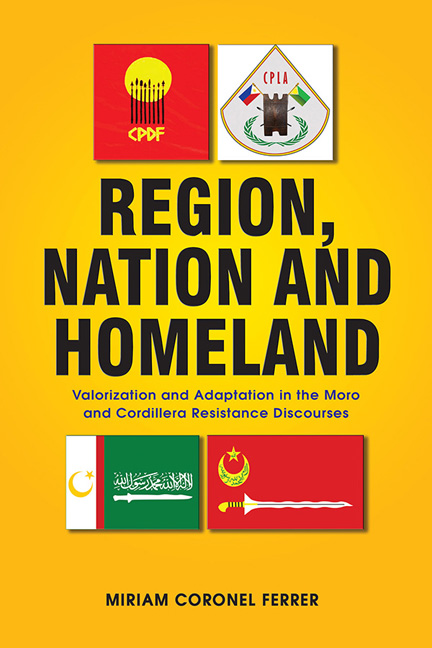 Region, Nation and Homeland
Region, Nation and Homeland Book contents
- Frontmatter
- Contents
- Preface
- List of Abbreviations
- Maps
- 1 Introduction: Text and Resistance
- 2 The Moro Liberation Movement: From Secession to Autonomy
- 3 The Cordillera Movement (1970s–2008): Building and Losing the Consensus
- 4 Nation, Homeland and Ancestral Domain: Intertextuality in the Moro Discourse
- 5 Identity Ambivalence in the Pan-Cordillera Discourse
- 6 Conclusion
- Bibliography
- Index
- About the Author
Preface
Published online by Cambridge University Press: 02 April 2020
- Frontmatter
- Contents
- Preface
- List of Abbreviations
- Maps
- 1 Introduction: Text and Resistance
- 2 The Moro Liberation Movement: From Secession to Autonomy
- 3 The Cordillera Movement (1970s–2008): Building and Losing the Consensus
- 4 Nation, Homeland and Ancestral Domain: Intertextuality in the Moro Discourse
- 5 Identity Ambivalence in the Pan-Cordillera Discourse
- 6 Conclusion
- Bibliography
- Index
- About the Author
Summary
The chapters in this book came from my long engagement with the Cordillera and Moro movements. I recall vividly the articles that we, as editors of the Philippine Collegian, the student paper of the University of the Philippines, bravely published on the developments in the Cordillera and Mindanao at the height of martial rule in the late 1970s. One month after graduation, I joined an international delegation that travelled to the hometown of Macli-ing Dulag, the revered chieftain of the Butbut tribe in Kalinga and the face and voice of the opposition to the Chico River Dam. In April 1980, soldiers assassinated Dulag, and our group travelled to Kalinga to show solidarity with the local people's struggle against the dam. Writing for the Diliman Review in the late 1980s, I had the opportunity to interview, among others, Conrado Balweg of the Cordillera People's Liberation Army and famed American historian and long-time Mountain Province resident William Henry Scott. During this tumultuous period, I had met and had discussions with many cadres from the Communist Party of the Philippines; I have had an inside track.
My direct involvement with the Moro movement came later, as part of my peace advocacy and new academic interest in conflict resolution and peace studies after the fall of the Marcos dictatorship. In the early 2000s I met Moro Islamic Liberation Front leaders Ebrahim Murad, the late Ali Lanang, and Mohager Iqbal as part of my advocacy work on the international campaign to ban landmines. In the Philippine Campaign to Ban Landmines, we urged different armed groups like the MILF to commit to a landmine ban. Little did I know that I would be thrust into a major role involving the MILF. In July 2010 I was appointed first as a member of President Benigno Simeon Aquino III's negotiating panel in talks with the MILF. From November 2012 to June 2016 I was the chair of the government panel that signed the Comprehensive Agreement on the Bangsamoro in March 2014.
This appointment took place after I had completed most of the research and had written the chapters that make up the bulk of this book. I have updated the 2010 drafts to take account of recent developments and other materials that have followed over the last few years. My visits to the Cordillera region in 2019 for another project allowed me to revalidate my analysis.
- Type
- Chapter
- Information
- Region, Nation and HomelandValorization and Adaptation in the Moro and Cordillera Resistance Discourses, pp. vii - viiiPublisher: ISEAS–Yusof Ishak InstitutePrint publication year: 2020
